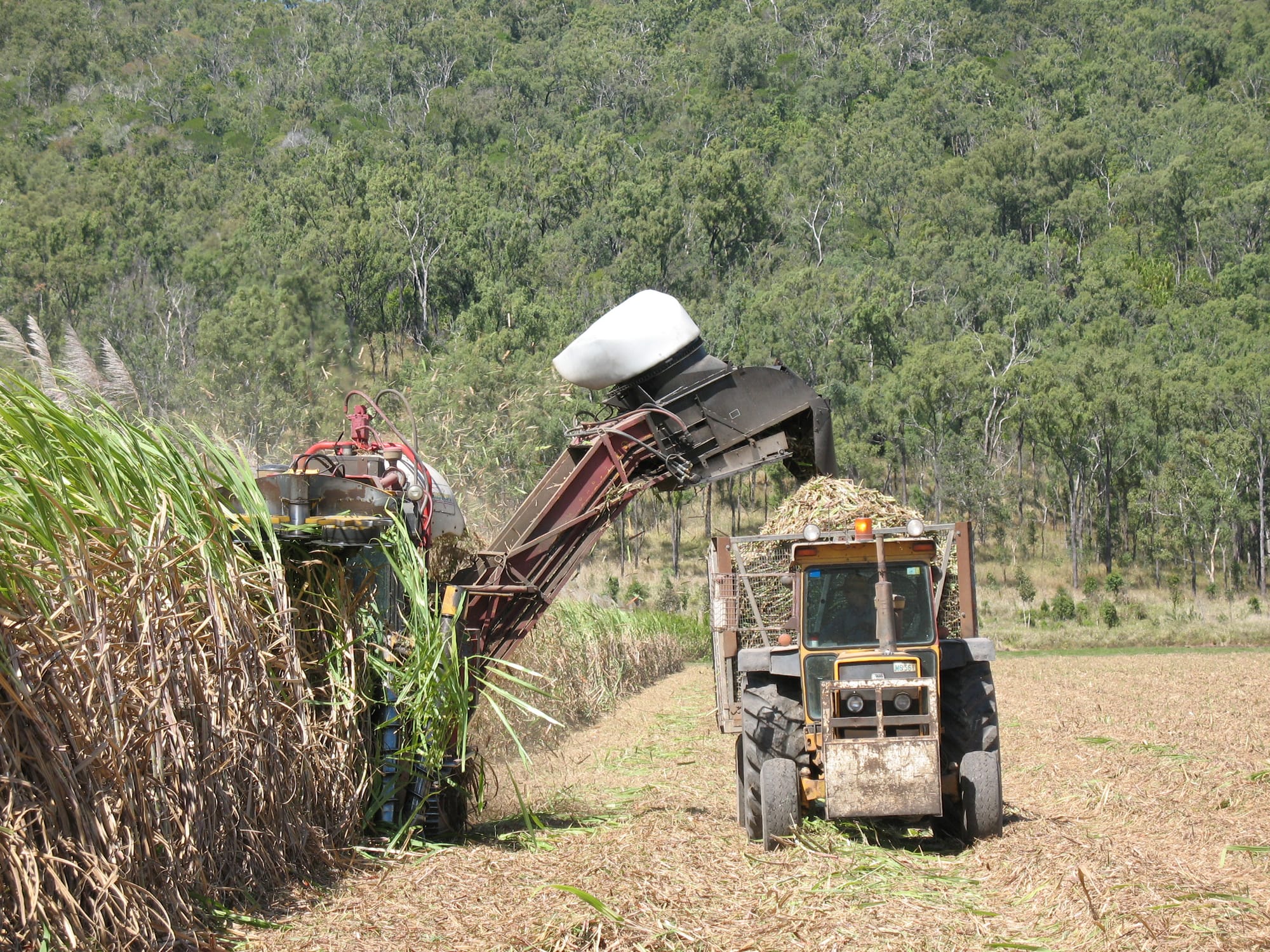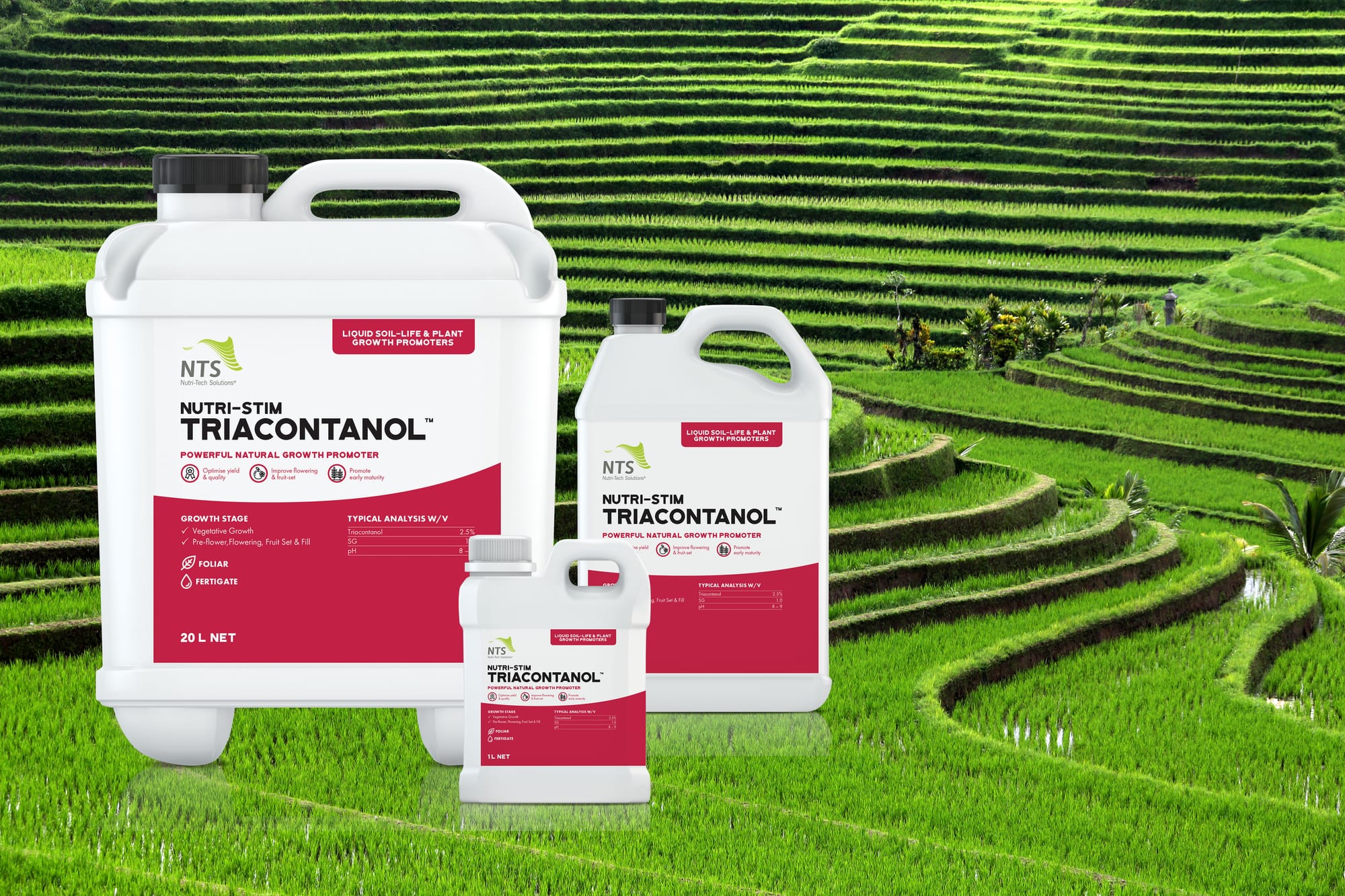10 Reasons to Try Nutri-Stim Triacontanol™

Triacontanol is a natural plant growth promoter derived from a fatty alcohol found in the waxy outer coating of the lucerne plant. I have explored a large number of inputs during the formulation of the diverse NTS product range, but this substance ranks amongst the most special.
If you have not yet worked with triacontanol on your farm, then this may be your opportunity to experiment. I’ve put together a summary of some of the qualities of triacontanol, but please feel free to supplement this with your own research. Then you may be motivated to take advantage of our special introductory offer.
Here are some examples of the exciting potential of this PGP.
1) Low cost yield builder
Triacontanol has been described as ‘the most powerful plant growth promoter ever researched’, and it truly deserves that extravagant claim. The good news is that it can cost as little as $2 per hectare to boost production. There is no other agricultural input offering so much, for so little.
2) Counters crop stress
In the brave new world of climate change farming, we desperately need tools to increase abiotic stress resilience. Heatwaves, hail, floods, frosts, storms, drought, and other extremes are making food production even more difficult. Multiple studies demonstrate the productive role triacontanol can play in alleviating crop stress.

3) Enhances photosynthesis
The single most important plant process is photosynthesis, where glucose, the building block of production, is created in little sugar factories called chloroplasts. The better your crop photosynthesises, the better your plant health and production. The mode of action of triacontanol involves a multi level boost of this critical process. It confers greater chlorophyll density, better stomatal opening for gas exchange, and it enhances the enzymes that drive sugar production in the plant.
4) Boosts mineral uptake and fertiliser efficiency
Similar to fulvic acid, triacontanol enhances the permeability of cell membranes, allowing greater mineral and nutrient uptake. This invaluable characteristic contributes to improved plant health and resilience, which, in turn, can increase yield and reduce fertiliser requirements. Several studies have reported marked increases in leaf levels of NPK following triacontanol applications (Singh, 2008; Wierzbowska et al. 2010; Nasir, 2009).
5) Softens salt stress impact
Salt is the most pervasive of all abiotic stressors and it results in many billions in global crop losses. Part of the reported benefit of triacontanol relates to marked increases in plant levels of calcium and potassium and associated reductions in sodium levels following application of triacontanol. Triacontanol appears to be a remarkable scavenger of the free radicals (ROS) linked to salt stress, and it dramatically increases the activity of antioxidant enzymes like superoxide dismutase (SOD) (Sarwar et al., 2021).
6) Increases plant biomass
In many instances, increased biomass means more profit. Sugar cane, forage crops and green vegetables are just some of those examples. This increase obviously relates to better photosynthesis and nutrient uptake, but there is another key determining factor. Triacontanol enhances natural hormones like auxins, cytokinins and gibberellins which, in turn impact, plant growth. This is part of the rationale behind the formulation of bestselling NTS product Brix-Fix™, which includes kelp, the highest source of these natural hormones, along with triacontanol and other synergists.

7) Builds protein levels
This is no small claim to fame, because it means much more than increased premiums for higher protein crops. Protein drives plant immunity, just as our own immune system is protein-based. Several studies have revealed significant increases in leaf levels of the nitrate reductase enzyme following applications of triacontanol. This is the molybdenum- dependent enzyme responsible for converting nitrate nitrogen in the leaf into protein.
8) Lifts yield and crop quality
There is much conjecture about the precise mode of action of this remarkable PGP, but there is a consensus that it rapidly triggers the production of a secondary messenger called 9-β-L(+)-Adenosine. This substance alters plant metabolism and leads to the biochemical changes that increase both yield and quality. The spike in 9-β-L(+)-Adenosine happens at an inexplicable pace. In an early study by Knowles and Ries (1981), a foliar application of triacontanol elicited a marked increase in 9-β-L(+)-Adenosine in the plant’s roots, in just one minute. As mentioned, this rapid fire action is difficult to explain, based on our current understanding of nutrient translocation. The yield and quality building potential is widely studied. In one famous study, triacontanol increased the dry weight, free amino acid content, reducing sugars and soluble protein content of both rice and maize within 5 minutes (Ries, 1991).
9) Minuscule application rates
Nutri-Stim Triacontanol is a super-concentrated formula that delivers impressive results at just 30 mL per hectare, as a foliar. However, there is some evidence that a foliar rate of 50 mL per hectare may be more productive. A Malaysian rice trial delivered a 61% yield increase at the higher rate. Fertigation rates are higher. We have discovered that fertigating 150 mL per hectare can deliver exciting outcomes in all crops.

10) Introductory offer 15% discount
If you are now motivated to trial this PGP on your pasture, field crops, orchard or vineyard, then we would like to encourage that trial by providing you with a 15% discount for any pack size of Nutri-Stim Triacontanol™. The 1 L bottle covers as much as 33 hectares (at the 30 mL/Ha rate). The 5 L drum delivers a single application to almost 170 hectares. The 20 L container provides a foliar coverage of 670 hectares, or multiple applications of smaller areas.
NTS distributors will also be offering the 15% discount.
Please note: This offer is available in Australia only. The offer ends February 2024.
You can place your order online here, or by phone on 07 5472 9900.
References
Knowles N.R. and Ries S.K. (1981) Rapid growth and apparent total nitrogen increase in rice and corn plants following application of triacontanol. Plant Physiol. 68: 1279–1284. https://doi.org/10.1104/pp.68.6.1279
Nasir S. (2009) Influence of triacontanol and macronutrient elements on the growth, yield and alkaloid content of Withania somnifera Dunal L. and Datura innoxia Mill. Doctoral dissertation, Aligarh Muslim University
Ries S. (1991) Triacontanol and its second messenger 9-β-L(+)-Adenosine as plant growth substances. Plant Physiol. 95: 986–989. https://doi.org/10.1104/pp.95.4.986
Sarwar M, Anjum, S, Ali, Q. et al. (2021) Triacontanol modulates salt stress tolerance in cucumber by altering the physiological and biochemical status of plant cells. Sci Rep 11, 24504. https://doi.org/10.1038/s41598-021-04174-y
Singh M. (2008) Influence of triacontanol, nitrogen and phosphorus on the growth, yield and quality of Ginger Zingiber officinale Rosc and Turmeric Curcuma longa. Doctoral dissertation, Aligarh Muslim University
Wierzbowska J, Sienkiewicz S, Bowszys T. Effect of growth regulators on the mineral balance in spring triticale. J Elem. 2010;15:745–756. [Google Scholar]
